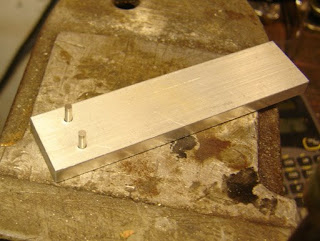
I thought the single taper looked too plain. The muzzle weight was a bit too boxy and formless for my taste. I cut a second taper for no good reason--except I wanted it to look a bit different. I was also fighting the compound slide's tendency to "rock" as it has only a single anchor point. I found that an extra tool post (the small black rectangle with the allen bolt in the middle) makes for a perfect secondary clamp to keep the compound firmly anchored to the cross slide. Rock gone, I continued cutting metal.

Not shown, I cut a few shallow grooves to add something else to look at.

Centered up and bolted down a V block to the drill press table. Spotted and drilled two holes for setscrews. Decided to use M5 x 0.8mm threads as Joe verified that he, indeed, has small metric allen wrenches. I believe the wrench size was a 2.5mm for the allen heads. To calculate the tapping drill size for METRIC threads, take the diameter and subtract the pitch. 5 - 0.8 = 4.2 mm to use for the drill bit size.

I saw this somewhere, either in Home Shop Machinist or Machinist Workshop. I chucked the M5 tap into the drill press and clamped a tap handle around the smooth body of the tap. Power off, and belt disengaged, I lowered the drill press and started turning the plug tap by hand. The idea is that this set-up aligns the tap in the vertical hole just made.

I thought it worked well, but I could've used a third hand. At some point, the tap handle does slip on the tap body, but at that point, the thread is started and can be finished out of the drill press by hand. As always, tapping oil is your best friend.

Here's where things went downhill. I cold blued the weight using my personal favorite Formula 44/40. After bluing, I oiled the part--and most of the blue came off leaving a thin gray color behind. Ack! I stipped the part on a brass wheel and tried Birchwood Casey Super Blue. The color took well, but seemed a rather bright blue with not enough black. I knew it wouldn't match the metal on the 850 Air Magnum so it got stripped off. I went back to the 44/40 and burnished it into the metal using almost dry patches.

The finish was a remarkable, even matte color. I oiled it lightly and took it over for a test fit on the gun. It was too small on the bore ID by about 0.002". What? You think these projects always go well the first time? Not in real life. At least not in mine. Dejectedly went home, and bored out the end a few extra thou to be on the safe side. Touched up and lightly oiled the finish. Next day, the weight looked good, so it got a more liberal coat of oil. 10 Hours later, it was absolutely covered in a fine layer of brown rust. I gave up on the finish. I hit it on a brass wheel yet again and gave it a quick shine with Mother's Mag Polish.
A second test fit and this time, it fit perfectly on the gun and we shot a couple magazines to verify POI.

My cohort will likely strip his bolt handle as well to match and he'll either keep a thin coat of oil or wax on the bare steel surfaces.

The brake ended up at exactly 7 oz. of additional weight for the muzzle.
So: I've come to the conclusion that there are some alloys of steel that just don't seem to "like" certain cold blues. A muzzle brake on another gun was finished with 44/40 over a year ago and it still looks like it was factory finished. Yet, other items have had flash rusting problems with Perma Blue, Super Blue and Dicropan T-4. A quick net search revealed that this is often a problem with cold blues and some will actually promote further rusting. If I can pry the brake away from my co-worker, I may try the 44/40 again, but rinse it thoroughly for about a half an hour in cold water, then immersing it in oil for a couple of days. My friend feels bad that I did all this work for such a simple thing. What he doesn't realize is that I learned more from the problems this time than from the successes. And sometimes that's just the way it goes.
















































